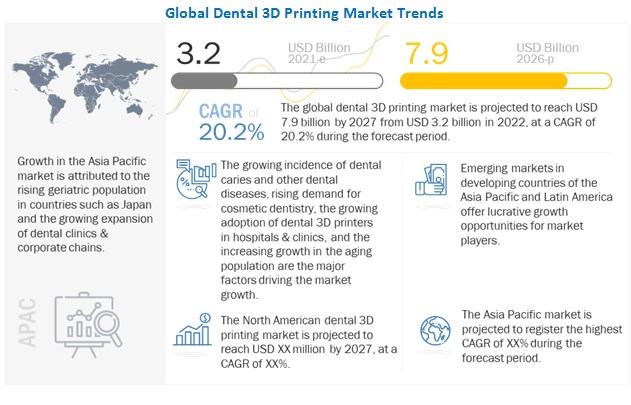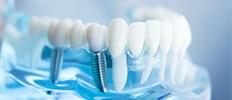The dental 3D printing market was initially negatively impacted by the COVID-19 pandemic, as most dental offices, clinics, and laboratories were closed in many parts of the world due to lockdowns and quarantine restrictions in early 2020. This resulted in all non-essential dental procedures being deferred; the volume of outpatient cases reduced considerably in this period.
In the pessimistic scenario, it could be assumed that the economic impact of the COVID-19 pandemic on the dental industry could affect the adoption of dental 3D printing due to its high capital and operational costs. However, this is unlikely, as market recovery is already seen in most regions at present.
[273 Pages Report] The dental 3D printing market is projected to reach USD 7.9 billion by 2027 from USD 3.2 billion in 2022, at a CAGR of 20.2%. The dental 3D printing medical devices market is principally driven by factors such as the increasing incidence of dental caries and other dental diseases, rising demand for cosmetic dentistry, the growing adoption of dental 3D printers in dental hospitals & clinics.
According to the CDC, in 2019, 64.9% of adults aged above 18 years of age had a dental examination or dental cleaning procedure. According to the American College of Prosthodontists, more than 36 million Americans are completely edentulous, and around 120 million Americans are missing at least one tooth. The number of partially edentulous patients is expected to increase to more than 200 million Americans in the next 15 years.

Download PDF Brochure @ https://www.marketsandmarkets.com/pdfdownloadNew.asp?id=258228239
With increasing disposable incomes, the willingness to undergo expensive cosmetic procedures has also risen, specifically among the aging population. Globally, there is a growing demand for dental restoration solutions and aesthetic treatments such as whitening and polishing.
According to a survey by the American Academy of Cosmetic Dentistry (AACD) in 2019, it was found that almost all the respondents had performed crowns, bonding, bridges, whitening, veneers, and dentures. Nonmembers remain less likely than members to do implants (64% to 73%) or recontouring (60% to 74%). However, both specialties increased for non-members by about 10% in 2019 compared to 2017.
Globally, there were 900 million persons aged 65 years or over in 2020. Since women live longer than men, on average, they comprise the majority of older persons, especially at advanced ages. Over the next three decades, the number of older persons worldwide is projected to more than double, reaching over 2 billion in 2050.
The lack of a workforce with a full understanding of the design process and production cycle in AM affects the final quality of the product. The lack of such a workforce would restrain the overall adoption of dental 3D printing.
